Parts List
- 1 Micro:bit Board
- 1 Micro:bit Battery Holder - 2x AA
- 1 Elecfreaks Micro:bit Breakout Board
- 1 Micro-B USB Data Cable
- 1 IIC OLED Display
- 1 TowerPro SG-90 Mini Servo Motor (1.6kg)
- 1 Octopus PIR Sensor Brick
- 1 Octopus Soil Moisture Sensor Brick
- 1 Octopus ADKeypad
- 1 Octopus Crash Sensor Brick
- 1 Octopus Passive Buzzer Brick OBPB01
- 1 Octopus 5mm LED Brick OBLED - Red
- 1 Octopus 5mm LED Brick - Green
- 1 Octopus 5mm LED Brick OBLED - Blue
- 1 Octopus Analog Rotation Brick OBARot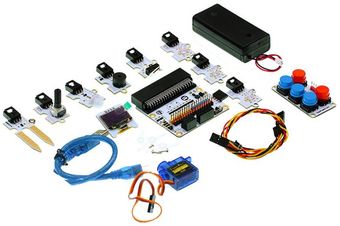
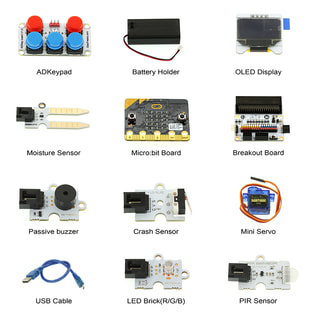
Kit Review
Overall, this kit is excellent, and I would definitely recommend this kit to newbies starting electronics in general, plus, this kit has many positive comments from me, such as:
1. The excellent packaging of all the individual modules and sensors. 2. The fact that all of the parts comes with the required accessory (wires, cables, battery box, etc..). 3. The parts' decent quality control, as it has been portrayed on them. 4. The wide variety of components in the kit itself (15 different components/sensors/modules). 5. The components individually, as they're very innovative and unique, differing from other brands, and, Elecfreaks are distributors of Octopus products. 6. If this kit was being compared to another kit, this clearly stand tall over the other as it involves a massive variety of products included, especially since it's worth its price.
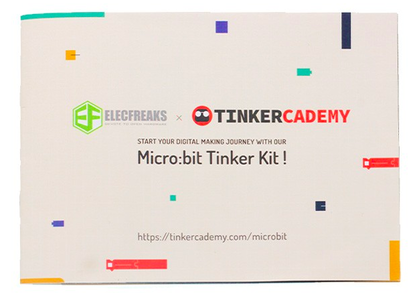
Micro:bit Specifications
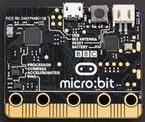
General
Type: Microcontroller
Architecture: For Micro:bit
Software: Code Kingdoms (Javascript) Microsoft Block Editor (Blocky & JavaScript), Microsoft TouchDevelop (Blocky & JavaScript) and Mu Editor (MicroPython)
Main Core Proccessor: 16MHz 32-bit ARM cortex-M0 microcontroller
Memory: 256KB flash and 16KB RAM
USB Interface Chip: Freescale MKL26Z128VFM4
Bluetooth Stack: Bluetooth 4.1 with BLE (Bluetooth Low Energy) /2.4GHz RF SoC (system-on-chip)
Sensitivity: -93dBM in Bluetooth Low Energy mode
TX Power: -20dBM to 4dBM in 4dB steps (Bluetooth)
Channels: 50 2MHz channels, only 40 used (0 to 39) and 3 advertising channels (37, 38 & 39) for Bluetooth
System Debugging: Jlink/OB
System Protocol: CMSIS-DP
Frequency Band: 2.4GHz for radio communication Programming, Software and Serial Input: Micro-B USB port
Compass: Freescale MAG3110 3-axis geomagnetic sensor
Accelerometer: Freescale MMA8653FC 3-axis accelerometer
Magnetometer: Freescale MAG3110 3-axis magnetometer
Temperature Sensor: On-core nRF51
Buttons: Two tactile user buttons and one tactile system button
Display type: Surface-mount red LEDs in a 5x5 matrix
GPIO (General Purpose Input/Output) pins: 19 usable GPIO pins for: i2c, light-sensing, digital input/output, PWM, serial transmit/receive, SPI, buttons, touch-sensing, and accessibility.
Input/Output Signal: Digital
Power
Operating Voltage: +1.8 - +3.6 volts
Maximum USB Current: 120 mA
Power Inputs: JST battery input, USB input, interface chip input or,
by the power pins
Maximum USB Current: 120 mA
Weight and Size Dimensions
Product Weight: 9g
Product Size (L x W x H): 5.13 x 4.32 x 1.13 cm
Pinout

Product Review
When this board arrived, I discovered many benefits from tinkering with this microcontroller which includes:
1. The many on-board sensors and modules it has, especially with its compact size.
2. The multiple softwares to write code and program the Micro:bit.
3. It's compatibility for all levels of makers in electronics.
4. The board being built with so many resources to learn and explore the Micro:bit (its libraries, forum, sample codes, support staff, etc.).
Blocks Micro:bit Sample Code
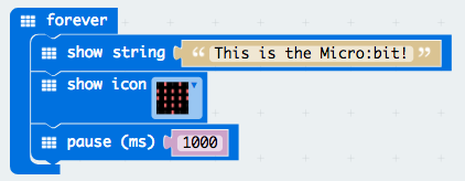 JavaScript Micro:bit Sample Code
JavaScript Micro:bit Sample Code
basic.forever(() => {
basic.showString("This is the Micro:bit!")
basic.showIcon(IconNames.Heart)
basic.pause(1000)
})
MicroPython Micro:bit Sample Code
from microbit import *
while True:
display.scroll("This is the Micro:bit!")
sleep(1000)
display.show(Image.HEART)
sleep(1000)
Micro:bit Battery Holder - 2xAA Specifications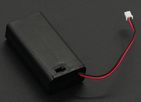
General
Type: Battery Holder
Architecture: For all electronics
Power
The voltage and current depends on the type of batteries inserted into the holder and the load which the holder is being drawn to.
Weight and Size Dimensions
Product Weight: 18g (without batteries)
Product Weight: 65g (with AA batteries)
Product Size (L x W x H): 6.7 x 3.2 x 1.7cm
Wire Length: 10.4 cm
Pinout
Red Wire - VCC (+)
Black Wire - GND (-)
Product Review
This battery holder contains features which offers extra, that could add more to your projects which includes the likes of:
1. A battery cover with screws, securing it into place well.
2. A JST connector as its output, making an easier connection to certain components and modules.
3. An ON/OFF switch for additional protection and control.
4. It's small size and compactness for smaller projects with minimal weight.
5. The rigid battery holder structure which fits two AA batteries with ease.
6. A lengthy and decent wire length, for longer connections and uses.
Elecfreaks Micro:bit Breakout Board Specifications
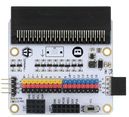
General
Type: Breakout Board
Architecture: For Micro:bit
Power
The power may vary as it depends on the power coming from the Micro:bit attached.
Signal Voltage (P19 & P16): +3.3 / +5 volts (interchangeable)
Weight and Size Dimensions
Product Weight: 29g (without Micro:bit attached)
Product Weight: 38g (with Micro:bit attached)
Product Size (L x W x H): 6.2 x 6 x 1 cm (without Micro:bit attached)
Product Size (L x W x H): 9.7 x 6 x 1 cm (with Micro:bit attached)
Pinout
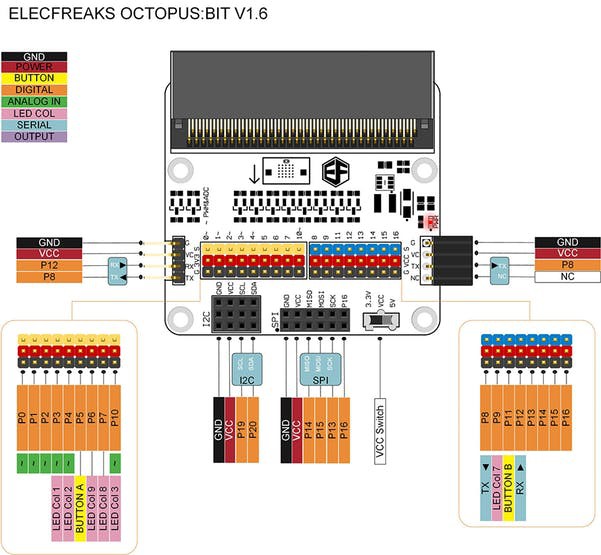
Product Review
This specific Micro:bit accessory is currently only being sold at Elecfreaks and Tinkercademy, but this rare product has features which helps us, like:
1. The access to pins from the Micro:bit which is difficult to reach with alligator clips.
2. The additional power, interface and signal pins for other modules.
3. The accessibility to the i2c and SPI interfaces for devices requiring those protocols.
4. The serial communication and programming pins to directly program the Micro:bit externally.
5. A signal power switch for compatibility with devices requiring different signal voltages.
The one error is that the VCC pins (the red row of pins) states that it is +3.3 volts, but it could be interchangeable to +5 volts via the power switch.
Micro-B USB Data Cable Specifications

General
Type: Data, Synchronisation, Power Cable
Architecture: For Micro:bit
Interface: Universal Serial Bus (USB)
Power
Power will depend on the load of the USB cable.
Maximum Operating Voltage: +5 volts (+0.25 / -0.60 volts)
Maximum Operating Current: 500 mA
Weight and Size Dimensions
Product Weight: 15g
Product Size (L x W x H): 30 x 1.4 x 0.8 cm
Pinout
Micro-B Male USB 2.0 Pinout
1 - VCC (+)
2 - Data -
3 - Data +
4 - NC (Not Connected)
5 - GND (-)
Type-A Male USB 2.0 Pinout

1 - VCC (+)
2 - Data -
3 - Data +
4 - GND (-)
Product Review
This particular USB 2.0 data cable, which was built for the Micro:bit, could be used for a variety of applications because it contains two common USB ports (Micro-B 2.0 and Type A 2.0), plus, this cable includes beneficial features such as:
1. The shorter length compared to other cables, it prevents tangles and this cable could be stored in limited space.
2. The multiple functions and purposes involved within a single cable which could be used for data, power and synchronisation. It could be also used in a wide range of applications in the electronics field as it isn't only an ordinary power cable for powering electronic devices.
3. The thick wiring involved in the interior of the cable for the transfer of power so that it could sustain its durability of the cable material while high current or voltages passes through it.
4. The stable connection to various USB female ports where both ends of the cable (Micro-B 2.0 and Type A 2.0) won't plug out easily.
IIC OLED Display Specifications
General
Type: Display
Architecture: For Micro:bit
Operating Temperature: -20°C - 70°C
Communication Method: IIC
Driver IC (Integrated Circuit): SSD1306
OLED Colour: Blue
Power
Operating Voltage: +3.3 - +5 volts
Operating Current: (Depends on the usage of the individual LEDs)
Weight and Size Dimensions
Diagonal Screen Size: 0.96" (2.4384 cm)
Resolution Size 128 x 64 pixels
Product Weight: 5g
Product Size (L x W x H): 2.7 x 2.8 x 1.06 cm
Pinout
G - GND (-)
V - VCC (+)
CL - SCL (Serial Clock)
DA - SDA (Serial Data
Product Review
This OLED, in particular, is really special from the ones I've bought in the past as the differing features includes:
1. Pre-soldered pins which makes setting up the OLED easier for a maker, compared to soldering the pin header on the OLED yourself.
2. The curved design at all the edges instead of pointed edges.
3. The smaller size and outline of the PCB compared to other OLED displays.
4. The pin markings at the back of the display, to minimize unnecessary wasted space, to cater for smaller projects.
With those aspects, I think that this OLED display needs to add mounting holes for projects and full pin markings so makers won't be so confused on the connections, the pinout and translation of the markings are to the right.
Blocks IIC OLED Display Sample Code
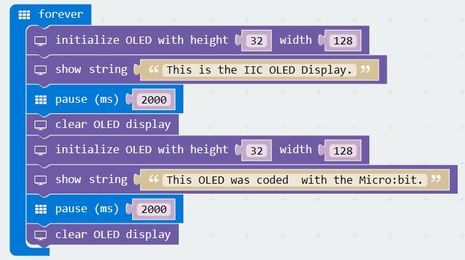 JavaScript IIC OLED Display Sample Code
JavaScript IIC OLED Display Sample Code
basic.forever(() => {
OLED.init(32, 128)
OLED.showString("This is the IIC OLED Display.")
basic.pause(2000)
OLED.clear()
OLED.init(32, 128)
OLED.showString("This OLED was coded with the Micro:bit.")
basic.pause(2000)
OLED.clear()
})
MicroPython IIC OLED Display Sample Code
# Please visit the following links below to see more on using the OLED Display with the Micro:bit on MicroPython
# as there're no finalized libraries made yet:
# https://github.com/fizban99/microbit_ssd1306
# https://gist.github.com/yuliantoeric/2eff0ed8fd2457f7862a8ea9979073ca
# https://github.com/Tinkertanker/pxt-ssd1306-microbit
# https://github.com/micropython/micropython/blob/479392a56e6edd8449e594c0e5c1e8f5176411ab/drivers/display/ssd1306.py
# https://github.com/khenderick/micropython-drivers
TowerPro SG-90 Mini Servo Moto (1.6 kg) Specifications
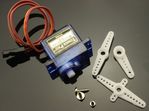
General
Type: Servo Motor
Architecture: For Micro:bit
Gear Material: Nylon and Plastic
Ferrite Type: 3-pole
Bearing: Top ball bearing
Rotation: Busing
Operating Speed (with no load): 0.12 seconds/60 degrees @ +4.8 volts
Stall Torque: 1.6kg/cm @ +4.8 volts
Operating voltage : +4.8 - +6 volts
Dead band width: 10 µs
Pulse Width: 500 - 2400 µs
Operating Temperature: 0°C - 55°C
Modulation: Analog
Power
Operating Voltage: +4.8 - +6 volts
Operating Current (no load): 500 - 1000 mA
Weight and Size Dimensions
Product Weight (with no accessories): 10g
Wire Length: 24.5 cm
Product Size (L x W x H): 3.2 x 1.2 x 3 cm (with no accessories)
Note: The SG-90 Servo Motor requires +4.8 - +6 volts power supply, it is recommended to use an external power supply while still using the Micro:bit for the signal pin to program the servo motor. For this, the Micro:bit breakout board is fine as it can give out +5 volts.
Pinout
Orange Wire - Signal
Red Wire - VCC (+)
Brown Wire - GND (-)
Product Review
This product is very common in the servo motor range, but this model is the one I mainly use due to features which includes:
1. The long life time of the servo with a project.
2. The lighter weight to suit smaller projects.
3. The durable material fitted in the interior of the motor and the case, protecting the motor well.
4. The powerful torque, giving access to a heavier load for larger projects, especially.
5. The precision rotations on this motor; especially when programmed for specific angle degrees.
6. The operations on this servo motor, as they're very smooth, especially with lengthy cycles and long-term uses.
Blocks TowerPro SG-90 Mini Servo Motor (1.6 kg) Sample Code
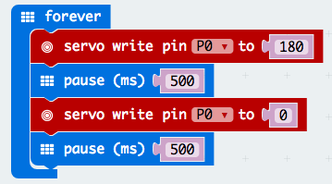 JavaScript TowerPro SG-90 Mini Servo Motor (1.6kg) Sample Code
JavaScript TowerPro SG-90 Mini Servo Motor (1.6kg) Sample Code
basic.forever(() => {
pins.servoWritePin(AnalogPin.P0, 180)
basic.pause(500)
pins.servoWritePin(AnalogPin.P0, 0)
basic.pause(500)
})
MicroPython TowerPro SG-90 Mini Servo Motor (1.6kg) Sample Code
from microbit import *
while True:
pin0.write_analog(180)
sleep(500)
pin0.write_analog(1)
sleep(500)
Octopus PIR Sensor Brick Specifications
General
Type: Sensor
Architecture: For Micro:bit
PIR Motion Chip: AM412
Operating Temperature: -25°C - 85°C
Sensing Distance: 4 -5 meters
Viewing Angle (X & Y): 65° (Overlook) / 50° (Side-look)
Output Signal: Digital
Power
Operating Voltage: +1.8 - +6 volts
Operating Current: 10 - 36 mA
Output High/Low Current: ± 10 mA
Weight and Size Dimensions
Product Weight: 6g
Wire Length: 27.2 cm
Product Size (L x W x H): 4.2 x 2.4 x 1.6 cm
Pinout
G (Black Wire) - GND (-)
V (Red Wire) - VCC (+)
S (Yellow Wire) - Signal
Product Review
This Octopus sensor brick can come in handy for many security or safety projects. With its massive variety of applications, some of its inviting features may include:
1. Its small breadth, so this sensor may be involved in portable or secretive projects regarding its uses, plus, it's minimal physical structure makes this sensor very compact to mount on any surface or project case.
2. The fairly simple hardware setup to the Micro:bit from this sensor, it's very direct to any user, as the connections comprise of three pins only with clear indications.
3. The software aspect for this sensor, it is covered in most of the programming software for the Micro:bit (Blocks, JavaScript and MicroPython) with libraries and additional packages for this kind of PIR motion sensor, making it easier to code.
4. Its advanced digital PIR Motion sensing driver chip, so it could have a better range and visibility towards its surroundings.
Blocks Octopus PIR Sensor Brick Sample Code JavaScript Octopus PIR Sensor Brick Sample Code
JavaScript Octopus PIR Sensor Brick Sample Code
basic.forever(() => {
if (pins.digitalReadPin(DigitalPin.P0) == 1) {
basic.showString("Motion!")
}
})
MicroPython Octopus PIR Sensor Brick Sample Code
from microbit import *
while True:
if pin0.read_digital():
display.scroll("Motion!")
Octopus Soil Moisture Sensor Brick Specifications 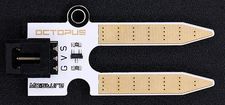
General
Type: Sensor
Architecture: For Micro:bit
Output Signal: Analog
Power
Operating Voltage: +3.3 - +5 volts
Operating Current: 35 mA
Output Signal Voltage: +0 - +4.2 volts
Weight and Size Dimensions
Product Weight: 5g
Wire Length: 26.3 cm
Product Size (L x W x H): 5.55 x 2.37 x 1 cm
Pinout
G (Black Wire) - GND (-)
V (Red Wire) - VCC (+)
S (Yellow Wire) - Signal
Product Review
This soil moisture sensor provides a good part in any environmental or plant monitoring projects and some facets of this product includes:
1. The very precise readings, being adaptive to slight changes in moisture.
2. The fast response time with high sensitivity to multiple various conditions of moisture.
3. The small, overall structure of this sensor, with an exceptionally short height for placing it in project boxes or using it in small-scale spots.
4. The simple hardware setup to a Micro:bit in which three connections will be made (VCC, GND and Signal).
5. The effortless software required, as receiving data from the sensor isn't hard with simple coding.
Blocks Octopus Soil Moisture Sensor Brick Sample Code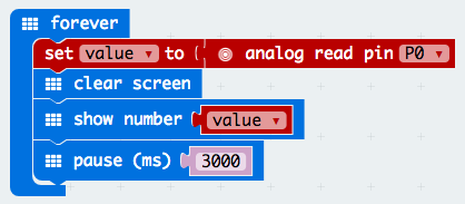 JavaScript Octopus Soil Moisture Sensor Brick Sample Code
JavaScript Octopus Soil Moisture Sensor Brick Sample Code
let value = 0
basic.forever(() => {
value = pins.analogReadPin(AnalogPin.P0)
basic.clearScreen()
basic.showNumber(value)
basic.pause(3000)
})
MicroPython Octopus Soil Moisture Sensor Brick Sample Code
from microbit import *
while True:
value = pin0.read_analog()
display.scroll(str(value))
sleep(3000)
Octopus ADKeypad
General
Type: Keypad
Architecture: For Micro:bit
Output Signal: Analog
Power
Operating Voltage: +3.3/+5 volts
Operating Current: 0.1 mA
Weight and Size Dimensions
Product Weight: 14g
Wire Length: 25 cm
Product Size (L x W x H): 5.44 x 2.85 x 1.6 cm
Pinout
G (Black Wire) - GND (-)
V (Red Wire) - VCC (+)
S (Yellow Wire) - Signal
Product Review
This distinct keypad contains some exclusive properties which diverges it from other common keypads, such as:
1. The two, different colour button caps included on the keypad already.
2. The simple software available with this keypad, as each button runs on a specific analog value.
3. The minimum hardware connections, as one signal line interconnects all of the buttons together for programming, as an input source.
4. The overall neatness of this product as all of its buttons are aligned properly and it uses slightly bigger buttons, rather than ordinary-sized buttons.
5. The placement of the five buttons, as it allows for button access when the keypad is held.
Blocks Octopus ADKeypad Sample Code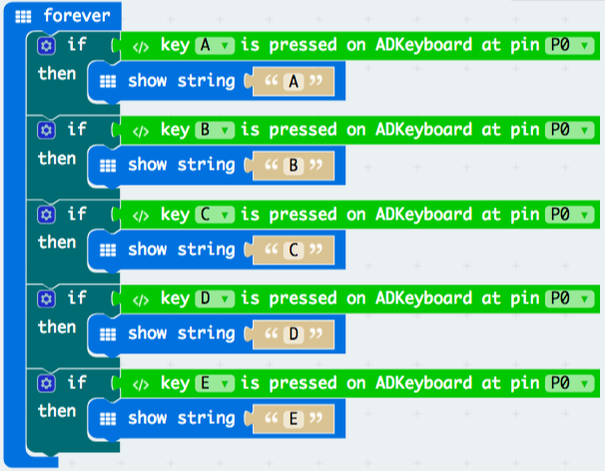 JavaScript Octopus ADKeypad Sample Code
JavaScript Octopus ADKeypad Sample Code
basic.forever(() => {
if (tinkercademy.ADKeyboard(ADKeys.A, AnalogPin.P0)) {
basic.showString("A")
}
if (tinkercademy.ADKeyboard(ADKeys.B, AnalogPin.P0)) {
basic.showString("B")
}
if (tinkercademy.ADKeyboard(ADKeys.C, AnalogPin.P0)) {
basic.showString("C")
}
if (tinkercademy.ADKeyboard(ADKeys.D, AnalogPin.P0)) {
basic.showString("D")
}
if (tinkercademy.ADKeyboard(ADKeys.E, AnalogPin.P0)) {
basic.showString("E")
}
})
MicroPython Octopus ADKeypad Sample Code
from microbit import *
while True:
if pin0.read_analog() < 10:
display.show('A')
if pin0.read_analog() > 40 and pin0.read_analog() < 60:
display.show('B')
if pin0.read_analog() > 80 and pin0.read_analog() < 110:
display.show('C')
if pin0.read_analog() > 130 and pin0.read_analog() < 150:
display.show('D')
if pin0.read_analog() > 530 and pin0.read_analog() < 560:
display.show('E')
Octopus Crash Sensor Brick Specifications General
General
Type: Sensor
Architecture: For Micro:bit
Output Signal: Digital
Power
Operating Voltage: +3.3/+5 volts
Operating Current: 0.1 mA
Weight and Size Dimensions
Product Weight: 5g
Wire Length: 25.2 cm
Product Size (L x W x H): 3.57 x 2.34 x 1.11 cm
Pinout
G (Black Wire) - GND (-)
V (Red Wire) - VCC (+)
S (Yellow Wire) - Signal
Product Review
Since there're not many crash sensor bricks like this certain brick, it encompasses some special highlights which includes the likes of:
1. The sensitivity of the sensor/switch, which could react to any crash or touch. The sensor easily senses a change in the digital state (1 or 0), whether the sensor is activated or not.
2. The whole layout and hardware of the board, which makes the board easy to place on a structure, plus, the three wires (VCC, GND and Signal) of this sensor is easy to hook up for programs to run.
3. The software interface, as it runs on a digital pin, where the sensor runs on an ON/OFF state only, so it makes it easy to operate another device connected to this sensor, as an output source.
Blocks Octopus Crash Sensor Brick Sample Code JavaScript Octopus Crash Sensor Brick Sample Code
JavaScript Octopus Crash Sensor Brick Sample Code
basic.forever(() => {
if (pins.digitalReadPin(DigitalPin.P16) == 0) {
basic.showString("Crashed!")
}
})
MicroPython Octopus Crash Sensor Brick Sample Code
from microbit import *
while True:
if pin16.read_digital() == False:
display.scroll("Crashed!")
Octopus Passive Buzzer Brick OBPB01 Specifications 
General
Type: Buzzer
Architecture: For Micro:bit
Output Signal: Analog
Power
Operating Voltage: +5 volts
Operating Current: 100 mA
Weight and Size Dimensions
Product Weight: 6g
Wire Length: 25.6 cm
Product Size (L x W x H): 3.65 x 2.34 x 1.13 cm
Pinout
G (Black Wire) - GND (-)
V (Red Wire) - VCC (+)
S (Yellow Wire) - Signal
Product Review
Based on the many passive buzzer modules I have, this is one of the modules I would select because it contains numerous factors, some of which are:
1. The compactness of this product for its usage when inputing this buzzer into a project box.
2. The volume of the sound it produces, which could be heard in a bigger area.
3. The clarity of the sound, in which when programmed for a specific frequency, the buzzer handles it well.
4. The extremely simple hardware connections and wiring this buzzer requires for microcontroller usage.
5. The fairly easy software needed in order to get this passive buzzer running efficiently.
Blocks Octopus Passive Buzzer Brick OBPB01 Sample Code
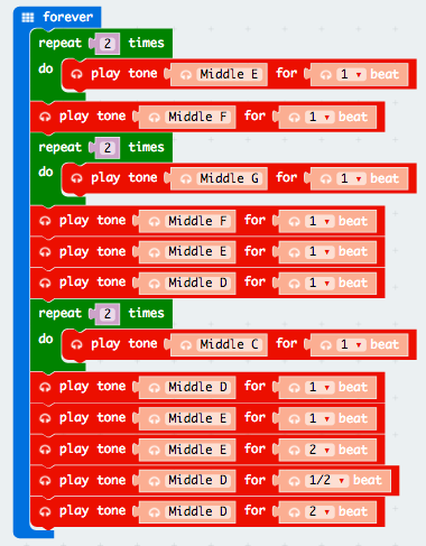 JavaScript Octopus Passive Buzzer Brick OBPB01 Sample Code
JavaScript Octopus Passive Buzzer Brick OBPB01 Sample Code
basic.forever(() => {
for (let i = 0; i < 2; i++) {
music.playTone(330, music.beat(BeatFraction.Whole))
}
music.playTone(349, music.beat(BeatFraction.Whole))
for (let i = 0; i < 2; i++) {
music.playTone(392, music.beat(BeatFraction.Whole))
}
music.playTone(349, music.beat(BeatFraction.Whole))
music.playTone(330, music.beat(BeatFraction.Whole))
music.playTone(294, music.beat(BeatFraction.Whole))
for (let i = 0; i < 2; i++) {
music.playTone(262, music.beat(BeatFraction.Whole))
}
music.playTone(294, music.beat(BeatFraction.Whole))
music.playTone(330, music.beat(BeatFraction.Whole))
music.playTone(330, music.beat(BeatFraction.Double))
music.playTone(294, music.beat(BeatFraction.Half))
music.playTone(294, music.beat(BeatFraction.Double))
})
MicroPython Octopus Passive Buzzer Brick OBPB01 Sample Code
import music
while True:
for count in range(2):
music.pitch(330, 500)
music.pitch(349, 500)
for count2 in range(2):
music.pitch(392, 500)
music.pitch(349, 500)
music.pitch(330, 500)
music.pitch(294, 500)
for count3 in range(2):
music.pitch(262, 500)
music.pitch(294, 500)
music.pitch(330, 500)
music.pitch(330, 1000)
music.pitch(294, 250)
music.pitch(294, 1000)
Octopus 5mm LED Brick OBLED - Red Specifications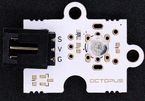
General
Type: LED (Light Emitting Diode)
Architecture: For Micro:bit
LED Colour: Red
Output Signal: Digital
Power
Operating Voltage: +3.3 - +5 volts
Operating Current: 5 mA
Weight and Size Dimensions
Product Weight: 5g
Wire Length: 27.5 cm
Product Size (L x W x H): 3.87 x 2.34 x 1 cm
Pinout
G (Black Wire) - GND (-)
V (Red Wire) - VCC (+)
S (Yellow Wire) - Signal
Product Review
This LED (Light Emitting Diode) Brick is fairly distinctive from ordinary LEDs as it has a capability to use digital interfaces. I like this module very much as it portrays specific traits inclusive of:
1. Its digital software input (LOW & HIGH/ 1 & 0) to program the LED Brick easily over software.
2. The module's control over brightness, which can be controlled via PWM (Pulse Width Modulation) for dimming or brightening up an area with the LED.
3. The simple physical connection from the LED Brick, as it consists of VCC, GND and Signal only.
4. The substantial layout of the LED and the PCB, as it is closely-packed to convert the original analog LED interface to a digital interface. The board can be fitted into boxes or onto surfaces directly.
Blocks Octopus 5mm LED Brick OBLED - Red Sample Code
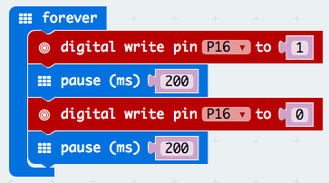 JavaScript Octopus 5mm LED Brick OBLED - Red Sample Code
JavaScript Octopus 5mm LED Brick OBLED - Red Sample Code
basic.forever(() => {
pins.digitalWritePin(DigitalPin.P16, 1)
basic.pause(200)
pins.digitalWritePin(DigitalPin.P16, 0)
basic.pause(200)
})
MicroPython Octopus 5mm LED Brick OBLED - Red Sample Code
from microbit import *
while True:
pin16.write_digital(1)
sleep(200)
pin16.write_digital(0)
sleep(200)
Octopus 5mm LED Brick - Green Specifications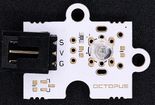
General
Type: LED (Light Emitting Diode)
Architecture: For Micro:bit
LED Colour: Green
Output Signal: Digital
Power
Operating Voltage: +3.3 - +5 volts
Operating Current: 5 mA
Weight and Size Dimensions
Product Weight: 5g
Wire Length: 26.5 cm
Product Size (L x W x H): 3.92 x 2.4 x 1.15 cm
Pinout
G (Black Wire) - GND (-)
V (Red Wire) - VCC (+)
S (Yellow Wire) - Signal
Product Review
The series of LED Bricks available in different variations can assist a maker in so many projects, especially visual displays with multiple colours. Just like others, this LED Brick comes with:
1. A digital software interface (LOW & HIGH/ 1 & 0) to program this brick with ease.
2. Access to PWM control, so this enables the brightness of the LED to change.
3. A simple physical attachment to connect the LED brick with something else, mainly because of the three-wire connection (VCC, GND and Signal).
4. The comprehensive PCB design and layout of this LED, keeping in mind that the original LED analog interface has been converted through this brick to feed into a microcontroller easily.
Blocks Octopus 5mm LED Brick - Green Sample Code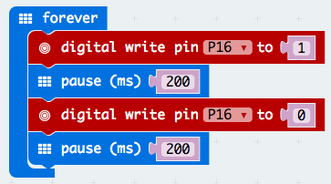 JavaScript Octopus 5mm LED Brick - Green Sample Code
JavaScript Octopus 5mm LED Brick - Green Sample Code
basic.forever(() => {
pins.digitalWritePin(DigitalPin.P16, 1)
basic.pause(200)
pins.digitalWritePin(DigitalPin.P16, 0)
basic.pause(200)
})
MicroPython Octopus 5mm LED Brick - Green Sample Code
from microbit import *
while True:
pin16.write_digital(1)
sleep(200)
pin16.write_digital(0)
sleep(200)
Octopus 5mm LED Brick OBLED - Blue Specifications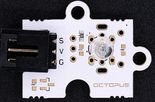
General
Type: LED (Light Emitting Diode)
Architecture: For Micro:bit
LED Colour: Blue
Output Signal: Digital
Power
Operating Voltage: +3.3 - +5 volts
Operating Current: 5 mA
Weight and Size Dimensions
Product Weight: 5g
Wire Length: 26.5 cm
Product Size (L x W x H): 3.67 x 2.42 x 11.8 cm
Pinout
G (Black Wire) - GND (-)
V (Red Wire) - VCC (+)
S (Yellow Wire) - Signal
Product Review
Just like the rest of the LED bricks in the variety of colours available, this Blue LED brick is no different from the rest. Therefore, it includes features which may include the likes of:
1. A digital software interface (LOW & HIGH / 1 & 0) to easily control the LED for turning it on or off. Furthermore, this brick enables PWM (brightness control), enabling to dim or brighten the LED.
2. A straightforward wiring setup from the LED to another device as an output, or as power. This brick consists of three main connections which simplifies the user's experience with using this product.
3. A fundamental PCB concept for this product, especially with its extensive features to convert an analog LED interface to a digital interface.
Blocks Octopus 5mm LED Brick OBLED - Blue Sample Code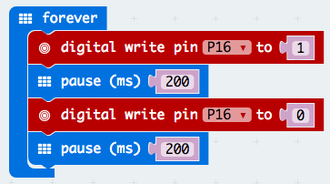
JavaScript Octopus 5mm LED Brick OBLED - Blue Sample Code
basic.forever(() => {
pins.digitalWritePin(DigitalPin.P16, 1)
basic.pause(200)
pins.digitalWritePin(DigitalPin.P16, 0)
basic.pause(200)
})
MicroPython Octopus 5mm LED Brick OBLED - Blue Sample Code
from microbit import *
while True:
pin16.write_digital(1)
sleep(200)
pin16.write_digital(0)
sleep(200)
Octopus Analog Rotation Brick OBARot Specifications 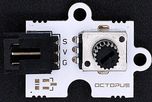
General
Type: Potentiometer
Architecture: For Micro:bit
Output Signal: Analog
Power
Operating Voltage: +5 volts
Operating Current: 0.05 mA
Weight and Size Dimensions
Product Weight: 7g
Wire Length: 25.7 cm
Product Size (L x W x H): 36.4 x 23 x 28.3 cm
Pinout
G (Black Wire) - GND (-)
V (Red Wire) - VCC (+)
S (Yellow Wire) - Signal
Product Review
This analog rotation brick, or potentiometer, is unique, because it's a brick, and everything is all integrated on the board. It includes traits like:
1. A 300-degree rotation scale with a wide detecting scope, resulting in a high sensitivity and a high response time towards all analog values.
2. Its simple software interface, as reading from this rotation brick requires a few lines of code, to find the analog value (0 to 1023) of the rotation, however, the max./min. turns only gives a value from 1 to 1020.
3. The potentiometer being turned into a brick, so that it requires three connections (VCC, GND and Signal).
Blocks Octopus Analog Rotation Brick OBARot Specifications JavaScript Octopus Analog Rotation Brick OBARot Sample Code
JavaScript Octopus Analog Rotation Brick OBARot Sample Code
input.onButtonPressed(Button.A, () => {
basic.showNumber(pins.analogReadPin(AnalogPin.P0))
})
MicroPython Octopus Analog Rotation Brick OBARot Sample Code
from microbit import *
while True:
if button_a.is_pressed():
value = pin0.read_analog()
display.show(str(value))
Elecfreaks Product Page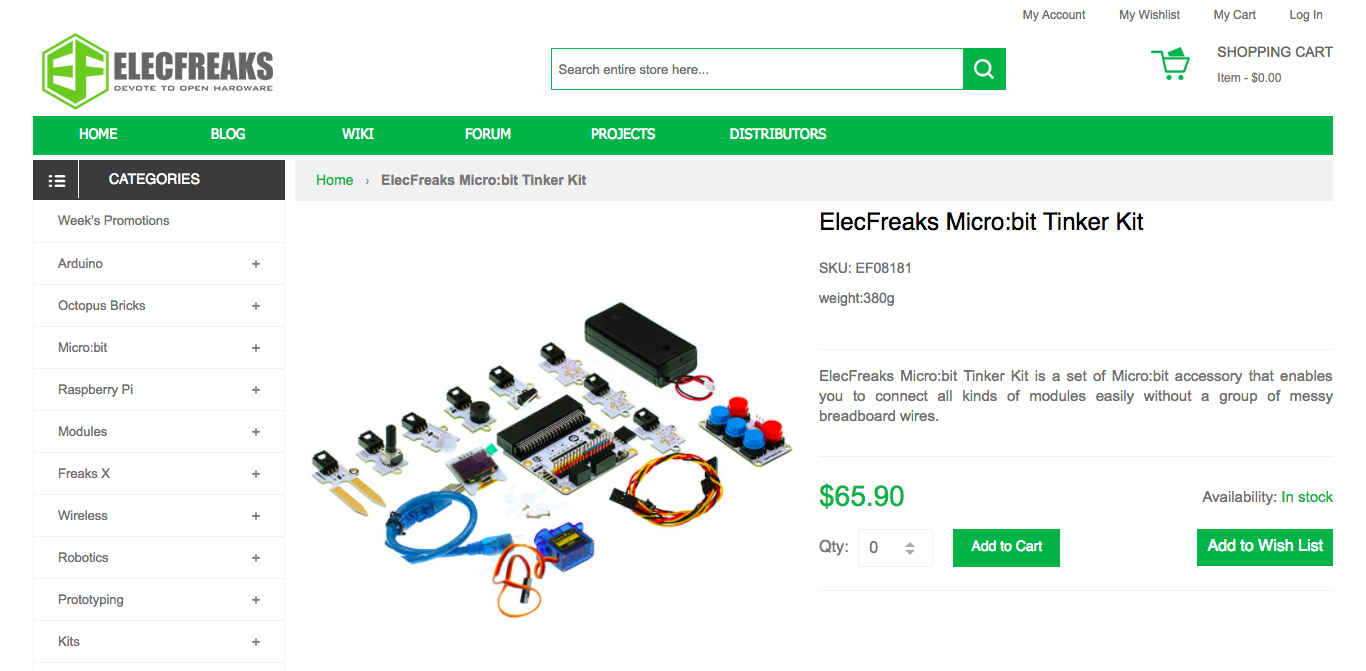 Check out the product here: http://www.elecfreaks.com/estore/elecfreaks-micro-bit-tinker-kit.html
Check out the product here: http://www.elecfreaks.com/estore/elecfreaks-micro-bit-tinker-kit.html
Sponsor Link:
UTSource.net Reviews
It is a trustworthy website for ordering electronic components with cheap price and excellent quality.
Amazing opportunities
Also, be sure to check out PCBWay, a leading manufacturer and distributor in PCB design and manufacturing. They have amazing prices and excellent quality in their services, so don't miss out on them! Plus, PCBWay has an amazing website, online Gerber viewer function and a gift shop so make sure to check out their links below:
PCBWay Free Online Gerber Viewer Function: https://www.pcbway.com/project/OnlineGerberViewer.html
PCBWay Gift Shop: https://www.pcbway.com/projects/gifts.html
Enjoy! Contact us for any inquiries!